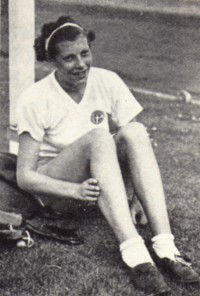Gabre Gabric dies at 101; starred in No. 1 masters documentary
From her Olympic reference bio:
Gabre Gabric was born in the town of Imotski in what was then Austro-Hungary and is now Croatia. At a young age she moved to the United States and lived in Chicago for several years before returning to the modern-day Croatian city of Zadar, which had become part of Italy following the First World War. During all these travels her official birthdate became muddled as a transcription error listed her year of birth as 1914, a date that would stick well into her masters-level athletic career.
Gabric took up the discus throw in 1934 and, by 1936, she was good enough to participate at that year’s Summer Olympic Games in Berlin where, despite finishing 10th in a field of 19 competitors, she broke [Vittorina Vivenza]’s Italian record in the event. Her next major stop was the 1938 European Championships, where she placed sixth, before setting a personal best of 43.35 in the event in 1939, which would have been sufficient for a bronze medal at the Berlin Olympics. Her career was interrupted by World War II but, between the 1936 and 1948 Summer Olympics, she was crowned Italian Champion four times (1937, 1939, 1940, 1942). At the London Games, however, she slipped to 17th out of 21 competitors. Her final major international competition was the 1950 European Championships, where she finished seventh.
Gabric married Sandro Calvesi, a hurdler, and their daughter, Lyana, married [Eddy Ottoz], who had been coached by Calvesi and won an bronze medal in the 110 metres hurdles event at the 1968 Summer Olympics. Lyana and Eddy had a son, [Laurent], who participated in the 1992 and 1996 Summer Games. It was Gabric, however, who would outlast them all in the athletic realm. A long-time competitor in masters-level athletics, she has won numerous European and World Masters Championships in the shot put, discus throw, and javelin. The Federazione Italiana di Atletica Leggera has kept the incorrect birth year of 1914, allowing her to compete in the W95 division, and she has set world records in the shot put, discus throw, weight throw, and throws pentathlon. Regardless of her exact age, she remains an outstanding athlete and, since the death of [Alfred Proksch] in 2011, was the last known track and field participant from the 1936 Olympics still competing.






7 Responses
I photographed Gabre at the 2009 Worlds in Lahti. I remember that she competed in the shot put in full make-up and jewelry. Quite a remarkable woman.
Rob, it would be nice to see these pictures. That would’ be be fitting tribute to the athlete that she was.
Terry, as you saw, I posted my favorite photo of Gabre on Facebook.
To appreciate the span of her life, she told me that her birthplace of Imotski has undergone 4 national designations during her lifetime. First, it was in Austro-Hungary (which ceased to exist after World War I), then it was in Croatia, then Croatia became subsumed into Yugoslavia, and finally Imotski became part of Croatia again after the dissolution of Yugoslavia.
Such an amazing woman and athlete.
Per IAAF
Last surviving 1936 Olympian
Thanks Rob for you photo on Facebook. Gabre had a full life. She looks full of grace and concentration as she throws the shot.
It was nice to see the IAAF acknowledge her participation in Masters track as part of their tribute to her.
I find it bittersweet to see the passing of our colleagues as milestones, yet I guess we all participate in our sport with the tacit acknowledgement that we ultimately can’t beat back time and fate forever. We just hope to enjoy a few more good meets like much like Gabre did.
Nice tribute by the IAAF:
http://www.iaaf.org/news/news/ljubica-gabre-gabric-dies
Yes, I think Gabre closed the book on veterans of the 1936 Olympics.
Swimmer Noel Morrow of Canada died in 2012. Noel was 17 when she competed in the ’36 Olympics. She didn’t a medal in Berlin, but she won Gold at the British Empire Games in Sydney in 1938.
I photographed her triumphant return to Sydney 71 years later when at the age of 90 she won multiple swimming Golds at the Sydney World Master Games.
Both Gabre and Noel were shining examples of lifetime commitment to their respective sports.
Leave a Reply